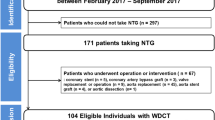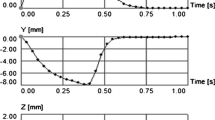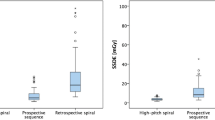Abstract
New protocols for coronary computed tomography angiography (CCTA) could lower the radiation dose for patients but influence the image quality. To compare image quality and radiation exposure in step-and-shoot CCTA and high-pitch spiral CCTA. Fifty-nine pairs of patients matched for weight, height, sex and heart rate were included in this study (74 m, 44 f, average age 60 years, age range 29–94 years). Step-and-shoot CCTA and high-pitch spiral CCTA was performed on a third generation dual-source CT in equally sized patient groups. The signal-to-noise ratio (SNR) in the ascending aorta and the coronary arteries were determined for each dataset. Image quality was rated using a five-point scale. We used the t-test for paired samples to compare SNR and effective dose, and the Wilcoxon test to compare image quality scores. Mean effective dose for the step-and-shoot protocol (4.15 ± 3.07 mSv) was significantly higher in comparison to the high-pitch spiral protocol (1.2 ± 0.69 mSv; p < 0.0001). Mean SNR was higher with the step-and-shoot protocol compared to the high-pitch spiral protocol in the aorta, in the left main and peripheral coronary arteries (p < 0.01), in the proximal right coronary artery (p = 0.027). Image quality scores were significantly better for the step-and-shoot protocol (p = 0.0003). Step-and-shoot CCTA has significantly better SNR and overall image quality compared to high-pitch spiral CCTA, but with a mean effective dose more than thrice as high.


Similar content being viewed by others
References
Roth GA, Huffman MD, Moran AE, Feigin V, Mensah GA, Naghavi M et al (2015) Global and regional patterns in cardiovascular mortality from 1990 to 2013. Circulation 132:1667–1678
Bhatnagar P, Wickramasinghe K, Williams J, Rayner M, Townsend N (2015) The epidemiology of cardiovascular disease in the UK 2014. Heart 101:1182–1189
Go AS, Mozaffarian D, Roger VL, Benjamin EJ, Berry JD, Blaha MJ et al (2014) Heart disease and stroke statistics—2014 update: a report from the American Heart Association. Circulation 129:e28–e292
Patel MR, Peterson ED, Dai D, Brennan JM, Redberg RF, Anderson HV et al (2010) Low diagnostic yield of elective coronary angiography. N Engl J Med 362:886–895
Dewey M, Zimmermann E, Deissenrieder F, Laule M, Dübel H-P, Schlattmann P et al (2009) Noninvasive coronary angiography by 320-row computed tomography with lower radiation exposure and maintained diagnostic accuracy: comparison of results with cardiac catheterization in a head-to-head pilot investigation. Circulation 120:867–875
Hsieh J, Londt J, Vass M, Li J, Tang X, Okerlund D (2006) Step-and-shoot data acquisition and reconstruction for cardiac X-ray computed tomography. Med Phys 33:4236–4248
Earls JP (2009) How to use a prospective gated technique for cardiac CT. J Cardiovasc Comput Tomogr 3:45–51
Baek S, Park SH, Won E, Park YR, Kim HJ (2015) Propensity score matching: a conceptual review for radiology researchers. Korean J Radiol 16:286–296
Pannu HK, Alvarez W, Fishman EK (2006) Beta-blockers for cardiac CT: a primer for the radiologist. Am J Roentgenol 186:S341–S345
Raju VM, Gosling OE, Morgan-Hughes G, Colliver RJ, Iyengar S, Dissanayake P et al (2014) High-dose intravenous metoprolol usage for reducing heart rate at CT coronary angiography: efficacy and safety. Clin Radiol 69:739–744
Cademartiri F, Nieman K, van der Lugt A, Raaijmakers RH, Mollet N, Pattynama PMT et al (2004) Intravenous contrast material administration at 16-detector row helical CT coronary angiography: test bolus versus bolus-tracking technique. Radiology 233:817–823
Sun K, Liu G-R, Li Y-C, Han R-J, Cui L-F, Ma L-J et al (2013) Intravenous contrast material administration at high-pitch dual-source CT coronary angiography: bolus-tracking technique with shortened time of respiratory instruction versus test bolus technique. Chin Med Sci J 27:225–231
Ulzheimer S, Endt H, Leidecker C (2011) CARE kV—How to optimize individualized dose. Siemens Med. Solut. USA, Inc. http://health.siemens.com/ct_applications/somatomsessions/index.php/care-kv-how-to-optimize-individualized-dose. Accessed 8 Mar 2016
Bongartz G, Golding SJ, Jurik AG, Leonardi M, van Meerten EP, Geleijns JM fl. EUR 16262 EN. http://www.drs.dk/guidelines/ct/quality/index.htm. Accessed 15 Feb 2019
Cerqueira MD (2002) Standardized myocardial segmentation and nomenclature for tomographic imaging of the heart: a statement for healthcare professionals from the Cardiac Imaging Committee of the Council on Clinical Cardiology of the American Heart Association. Circulation 105:539–542
Landis JR, Koch GG (1977) The measurement of observer agreement for categorical data. Biom Int Biom Soc 33:159
R Core Team (2017) R: a language and environment for statistical computing. http://www.r-project.org/. Accessed 23 July 2018
Randolph JJ, Falbe K, Manuel AK, Balloun JL (2014) A step-by-step guide to propensity score matching in R. Pract Assess Res Eval 19. http://eric.ed.gov/?id=EJ1046892. Accessed 2 May 2016
Armstrong RA (2014) When to use the Bonferroni correction. Ophthalmic Physiol Opt 34:502–508
Curtin F, Schulz P (1998) Multiple correlations and Bonferroni’s correction. Biol Psychiatry 44:775–777
Smettei OA, Sayed S, Al Habib MA, Alharbi F, Abazid RM (2018) Ultra-fast, low dose high-pitch (FLASH) versus prospectively-gated coronary computed tomography angiography: comparison of image quality and patient radiation exposure. J Saudi Heart Assoc 30:165–171
Ghadri JR, Küest SM, Goetti R, Fiechter M, Pazhenkottil AP, Nkoulou RN et al (2012) Image quality and radiation dose comparison of prospectively triggered low-dose CCTA: 128-slice dual-source high-pitch spiral versus 64-slice single-source sequential acquisition. Int J Cardiovasc Imaging 28:1217–1225. https://doi.org/10.1007/s10554-011-9921-3
Wang W, Zhao YE, Qi L, Li X, Zhou CS, Zhang LJ et al (2017) Prospectively ECG-triggered high-pitch coronary CT angiography at 70 kVp with 30 mL contrast agent: an intraindividual comparison with sequential scanning at 120 kVp with 60 mL contrast agent. Eur J Radiol 90:97–105
Zanzonico P, Dauer L, Strauss HW (2016) Radiobiology in cardiovascular imaging. JACC Cardiovasc Imaging 9:1446–1461
Huang B, Li J, Law MW-M, Zhang J, Shen Y, Khong PL (2010) Radiation dose and cancer risk in retrospectively and prospectively ECG-gated coronary angiography using 64-slice multidetector CT. Br J Radiol 83:152–158. https://doi.org/10.1259/bjr/29879495
Gebhard C, Fuchs TA, Stehli J, Gransar H, Berman DS, Budoff MJ et al (2015) Coronary dominance and prognosis in patients undergoing coronary computed tomographic angiography: results from the CONFIRM (COronary CT Angiography EvaluatioN For Clinical Outcomes: an international multicenter) registry. Eur Heart J Cardiovasc Imaging 16:853–862
Sakamoto S, Takahashi S, Coskun AU, Papafaklis MI, Takahashi A, Saito S et al (2013) Relation of distribution of coronary blood flow volume to coronary artery dominance. Am J Cardiol 111:1420–1424
Funding
This study was not supported by any funding.
Author information
Authors and Affiliations
Corresponding author
Ethics declarations
Conflict of interest
The authors declare that they have no conflict of interest.
Consent for publication
Consent for publication was obtained for every individual person’s data included in the study.
Ethical approval
All procedures performed in studies involving human participants were in accordance with the ethical standards of the institutional and/or national research committee and with the 1964 Helsinki declaration and its later amendments or comparable ethical standards.
Informed consent
Informed consent was obtained from all individual participants included in the study.
Additional information
Publisher’s Note
Springer Nature remains neutral with regard to jurisdictional claims in published maps and institutional affiliations.
Rights and permissions
About this article
Cite this article
Seppelt, D., Kolb, C., Kühn, J.P. et al. Comparison of sequential and high-pitch-spiral coronary CT-angiography: image quality and radiation exposure. Int J Cardiovasc Imaging 35, 1379–1386 (2019). https://doi.org/10.1007/s10554-019-01568-y
Received:
Accepted:
Published:
Issue Date:
DOI: https://doi.org/10.1007/s10554-019-01568-y




